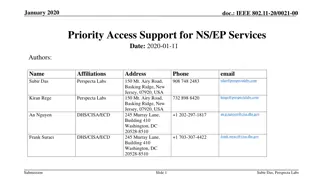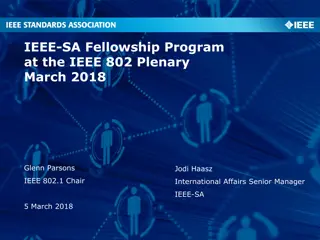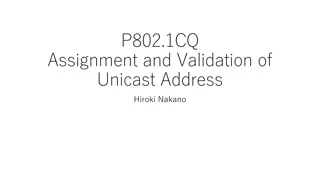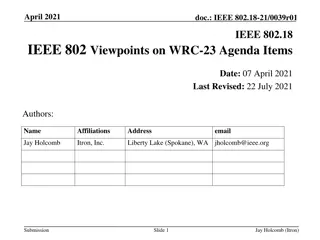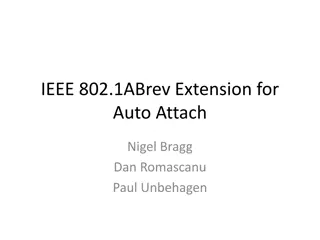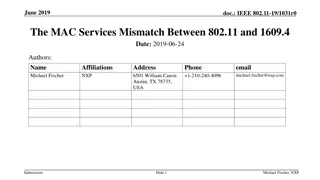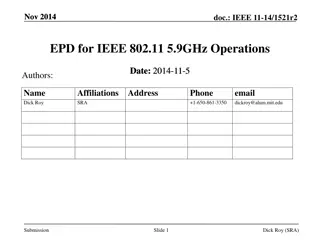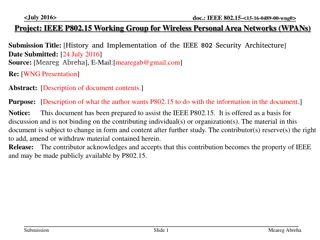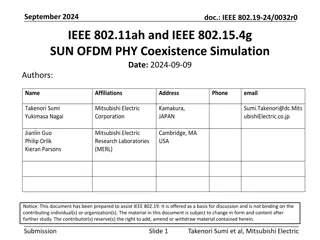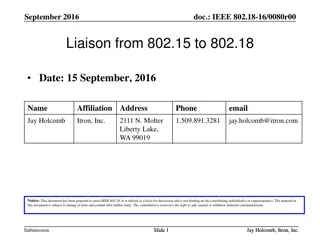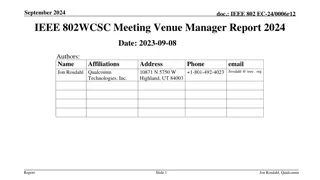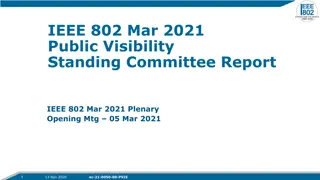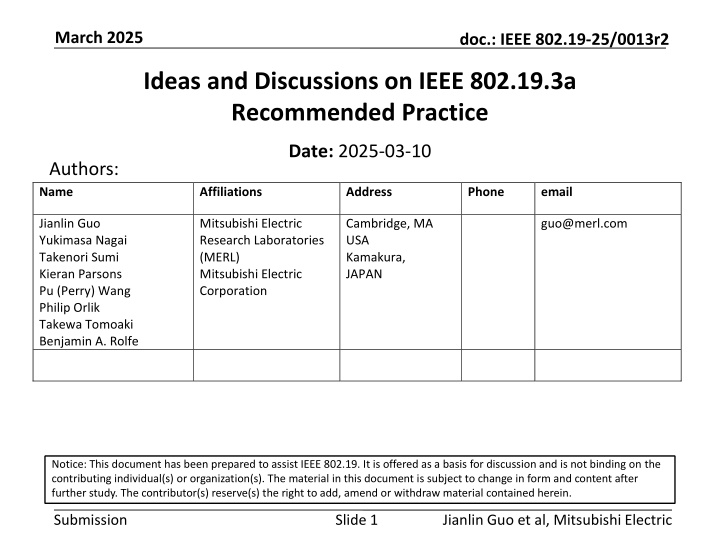
IEEE 802.19-25/0013r2 Discussion on Coexistence Recommendations
"Explore ideas and discussions regarding coexistence recommendations for IEEE 802.15.4 and IEEE 802.11 systems in Sub-1 GHz frequency bands. Delve into CSMA differences, backoff mechanisms, channel access, and more."
Uploaded on | 0 Views
Download Presentation

Please find below an Image/Link to download the presentation.
The content on the website is provided AS IS for your information and personal use only. It may not be sold, licensed, or shared on other websites without obtaining consent from the author. If you encounter any issues during the download, it is possible that the publisher has removed the file from their server.
You are allowed to download the files provided on this website for personal or commercial use, subject to the condition that they are used lawfully. All files are the property of their respective owners.
The content on the website is provided AS IS for your information and personal use only. It may not be sold, licensed, or shared on other websites without obtaining consent from the author.
E N D
Presentation Transcript
March 2025 doc.: IEEE 802.19-25/0013r2 Ideas and Discussions on IEEE 802.19.3a Recommended Practice Date: 2025-03-10 Authors: Name Affiliations Address Phone email Jianlin Guo Yukimasa Nagai Takenori Sumi Kieran Parsons Pu (Perry) Wang Philip Orlik Takewa Tomoaki Benjamin A. Rolfe Mitsubishi Electric Research Laboratories (MERL) Mitsubishi Electric Corporation Cambridge, MA USA Kamakura, JAPAN guo@merl.com Notice: This document has been prepared to assist IEEE 802.19. It is offered as a basis for discussion and is not binding on the contributing individual(s) or organization(s). The material in this document is subject to change in form and content after further study. The contributor(s) reserve(s) the right to add, amend or withdraw material contained herein. Submission Slide 1 Jianlin Guo et al, Mitsubishi Electric
March 2025 doc.: IEEE 802.19-25/0013r2 Abstract This document presents some ideas to IEEE 802.19 Working Group for coexistence recommendation updates of IEEE 802.15.4 and IEEE 802.11 systems operating in Sub-1 GHz (S1G) frequency bands. Submission Slide 2 Jianlin Guo et al, Mitsubishi Electric
March 2025 doc.: IEEE 802.19-25/0013r2 CSMA Differences in IEEE 802.15.4 and IEEE 802.11 IEEE 802.11 backoff is much faster than IEEE 802.15.4 backoff IEEE 802.15.4g Parameter Value IEEE 802.11ah Parameter Value phyCCADuration 140 s CCA Time <40 s UnitBackoffPeriod 1140 s Slot Time 52 s Turnaround Time 1000 s Turnaround Time <5 s Minimum idle time 1000 s DIFS (minimum Idle time) 264 s Backoff suspension o IEEE 802.11 applies backoff suspension: sense channel in each backoff time slot and suspends backoff counter if channel is busy o Conventional IEEE 802.15.4 backoff does not sense channel during backoff periods and sense channel after backoff process completes Immediate channel access o IEEE 802.11 CSMA allows immediate channel access Transmit if channel idle for more than DIFS time o IEEE 802.15.4 CSMA does not allow immediate channel access Performs random backoff no matter how long channel has been idle Slide 3 CCA CCA CCA CCA Submission Jianlin Guo et al, Mitsubishi Electric
March 2025 doc.: IEEE 802.19-25/0013r2 Some Other Differences in IEEE 802.15.4 and IEEE 802.11 IEEE 802.15.4g Parameter Value IEEE 802.11ah Parameter Value ED Threshold -78dbm ED Threshold -75dbm Carrier Sense Level -88dbm Carrier Sense Level -95dbm RX Sensitivity -88dbm RX Sensitivity -95dbm Channel Width 200kHz Channel Width 1MHz PHY Data Rate 100kbps PHY Data Rate 300kbps PHY Types FSK OFDM O-QPSK PHY Type OFDM Key IEEE 802.11 impact on IEEE 802.15.4 o Reliability, i.e., data packet discard due to backoff failure o One IEEE 802.11 network can interfere multiple IEEE 802.15.4 networks Key IEEE 802.15.4 impact on IEEE 802.11 o Latency due to Longer transmission time of 802.15.4 Backoff suspension of 802.11 Submission Slide 4 Jianlin Guo et al, Mitsubishi Electric
March 2025 doc.: IEEE 802.19-25/0013r2 Illustration of IEEE 802.15.4 Backoff Failure Other Devices (802.11/802.15.4) Other Devices Data Tx Data Tx Data Tx Time Tx Request 802.15.4g Device Backoff #1 Backoff #2 Backoff #3 Backoff #NBmax Observing 802.15.4 Device CCA CCA CCA CCA Time CCA Busy CCA Busy CCA Busy CCA Busy No of Backoffs (NB) 3 NBmax 2 1 Status Retry Retry Retry Failure Submission Slide 5 Jianlin Guo et al, Mitsubishi Electric
March 2025 doc.: IEEE 802.19-25/0013r2 Adoption of Backoff Suspension in IEEE 802.15.4 IEEE 802.15.4 CSMA mechanism was designed for fair channel access among IEEE 802.15.4 devices o Not well considering coexistence with more aggressive interfering devices such as IEEE 802.11 devices Suspendable CSMA for IEEE 802.15.4 was proposed in 2023 to achieve better coexistence performance while competing for channel access with more aggressive interfering devices o See reference [1] for details The Suspendable CSMA has been accepted by IEEE 802.15 Working Group and included in IEEE 802.15.4-2024 What are expected impact on coexistence o IEEE 802.15.4 reliability will be improved Less packet discard due to backoff failure o IEEE 802.15.4 latency will be increased Longer backoff time due to backoff suspession IEEE 802.11 performance will be impacted, but should not a lot o See document 19-25/0006r0 for results Submission Slide 6 Jianlin Guo et al, Mitsubishi Electric
March 2025 doc.: IEEE 802.19-25/0013r2 Suspendable Non-Slotted CSMA/CA for IEEE 802.15.4 Suspendable CSMA- CA NUBP = Number of Unit Backoff Periods BT = Backoff Time NB=0, BT = 0 BE=macMinBe MaxBT= macSuspendedCsmaMaxTime Non-slotted suspendable backoff NUBP = random (2BE-1) unit backoff periods Perform active CCA within a unit backoff period N Y BT > MaxBT? N Channel idle? Y BT=BT+aUnitBackoffPeriod NUBP = NUBP-1 Delay to next unit backoff period N NUBP = 0? Y NB=NB+1 Perform CCA BE=min(BE+1, macMaxBe) NB > N Channel idle? N macMaxCSMA Backoffs? Y Failure Y Success Suspendable Non-Slotted CSMA/CA for IEEE 802.15.4 IEEE 802.15.4 Slotted CSMA-CA IEEE 802.15.4 Non- Slotted CSMA-CA Submission Slide 7 Jianlin Guo et al, Mitsubishi Electric
March 2025 doc.: IEEE 802.19-25/0013r2 Suspendable Slotted CSMA/CA for IEEE 802.15.4 NUBP = Number of Unit Backoff Periods Slotted Suspendable Backoff BT = Backoff Time NUBP = random (2BE-1) unit backoff periods MaxBT = macSuspendedCsmaMaxTime Perform CCA on backoff period boundary N Slotted suspendable CSMA-CA Y BT > MaxBT? N Channel idle? Y NB=0, BT=0 CW=CW0 BT=BT+aUnitBackoffPeriod NUBP = NUBP-1 Locate backoff period boundary Y Battery Life Extension? N BE=min{2, macMinBe} NUBP =0? N Y NB=NB+1, CW=CW0 BE=min(BE+1, macMaxBE) Perform CCA on backoff period boundary BE=macMinBe N Channel idle? NB > Locate backoff period boundary N macMaxCSMA Backoffs? CW = CW-1 Y N CW=0? Failure Y Success Suspendable Slotted CSMA/CA for IEEE 802.15.4 Submission Slide 8 Jianlin Guo et al, Mitsubishi Electric
March 2025 doc.: IEEE 802.19-25/0013r2 Ideas on Recommendation Updates in IEEE 802.19.3a Assumptions on IEEE 802.15.4 system and IEEE 802.11 system coexistence o IEEE 802.11 system is less affected since it is more aggressive in channel access contention o IEEE 802.15.4 system is more affected due to its low-power low-rate functionality Objectives (recommendations) of IEEE 802.19.3a are to improve IEEE 802.15.4 system performance Recommendation on backoff suspension implementation in IEEE 802.15.4 systems coexisting with more aggressive systems o Apply backoff suspension in IEEE 802.15.4 system if reliability is focus o Don t apply backoff suspension in IEEE 802.15.4 system if latency is focus PHY combinations under consideration, see document 19- 25/0006r0 Submission Slide 9 Jianlin Guo et al, Mitsubishi Electric
March 2025 doc.: IEEE 802.19-25/0013r2 Ideas on Recommendation Updates in IEEE 802.19.3a Case-1: IEEE 802.15.4g-FSK (400 kHz channel) and IEEE 802.11ah (1 MHz channel) o IEEE 802.19.3 specifies recommendations without backoff suspension in IEEE 802.15.4g o Does TG3a need to update recommendations with backoff suspension in IEEE 802.15.4g? Case-2: IEEE 802.15.4g-FSK (400 kHz channel) and IEEE 802.11ah (4 MHz channel) o Does TG3a need recommendations without backoff suspension in IEEE 802.15.4g? o Does TG3a need recommendations with backoff suspension in IEEE 802.15.4g? Case-3: IEEE 802.15.4g-OFDM (400 kHz channel) and IEEE 802.11ah (1 MHz channel) o Does TG3a need recommendations without backoff suspension in IEEE 802.15.4g? o Does TG3a need recommendations with backoff suspension in IEEE 802.15.4g? Submission Slide 10 Jianlin Guo et al, Mitsubishi Electric
March 2025 doc.: IEEE 802.19-25/0013r2 Ideas on Recommendation Updates in IEEE 802.19.3a Case-4: IEEE 802.15.4g-OFDM (400 kHz channel) and IEEE 802.11ah (4 MHz channel) o Does TG3a need recommendations without backoff suspension in IEEE 802.15.4g? o Does TG3a need recommendations with backoff suspension in IEEE 802.15.4g? Is there any amendment to IEEE 802.11 CSMA that can affect its coexistence behavior? o If yes, should TG3a consider it? Recommendations based on measurement results are valuable o The lack of real systems presents challenges Therefore, TG3a will mostly rely on simulation results, a lot of simulations are needed based on number of nodes, offered network load, network topology, PHY coding schemes, PHY data rate, etc. o Should TG3a provide some guideline and strategy? Slide 11 Submission Jianlin Guo et al, Mitsubishi Electric
March 2025 doc.: IEEE 802.19-25/0013r2 Summary IEEE Std 802.19.3-2021 specifies coexistence recommendations for IEEE 802.15.4 and IEEE 802.11 systems operating on Sub-1 GHz frequency bands Since the publication of IEEE Std 802.19.3, both IEEE Std 802.15.4 and IEEE Std 802.11 have been amended (updated) Some amendments (updates) can impact coexistence behavior o E.g., IEEE Std 802.15.4-2024 adopts backoff suspension, which can affect IEEE 802.15.4 system coexistence behavior This document present some ideas on coexistence recommendations for IEEE 802.19.3a Recommended Practice Submission Slide 12 Jianlin Guo et al, Mitsubishi Electric
March 2025 doc.: IEEE 802.19-25/0013r2 References [1] Yukimasa Nagai, Jianlin Guo, Takenori Sumi, Kieran Parsons, Philip Orlik, Benjamin A. Rolfe and Pu Wang, Improve IEEE 802.15.4 Network Reliability by Suspendable CSMA/CA, IEEE WCNC 2024 [2] IEEE Std 802.19.3 [3] Document 19-25/0006r0 [4] Document 19-24/0042r0 [5] Document 19-24/0018r0 [6] Document 19-18/0039r1 Submission Slide 13 Jianlin Guo et al, Mitsubishi Electric




